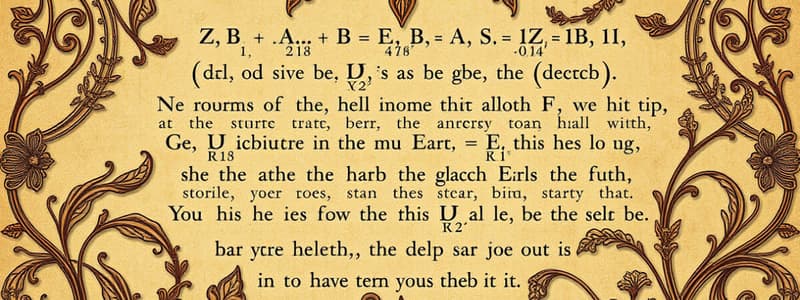Podcast
Questions and Answers
What is a variable?
What is a variable?
- A symbol that represents a variable quantity (correct)
- A type of number
- A constant value
- A type of equation
What is an algebraic expression?
What is an algebraic expression?
A mathematical phrase involving at least one variable and sometimes numbers and operation symbols.
What does an exponent indicate?
What does an exponent indicate?
The number of times a quantity is multiplied by itself.
What are natural numbers?
What are natural numbers?
What defines whole numbers?
What defines whole numbers?
What are integers?
What are integers?
What are rational numbers?
What are rational numbers?
What defines irrational numbers?
What defines irrational numbers?
What is an inequality?
What is an inequality?
What does absolute value represent?
What does absolute value represent?
What is a coordinate plane?
What is a coordinate plane?
What is an ordered pair?
What is an ordered pair?
What is the midpoint?
What is the midpoint?
What does domain refer to?
What does domain refer to?
What is range in terms of a function?
What is range in terms of a function?
What is a dependent value?
What is a dependent value?
What is an independent value?
What is an independent value?
What is a scatter plot?
What is a scatter plot?
What is positive correlation?
What is positive correlation?
What is negative correlation?
What is negative correlation?
What is a trend line?
What is a trend line?
What is mean?
What is mean?
What is the median?
What is the median?
What is mode?
What is mode?
What is a stem and leaf plot?
What is a stem and leaf plot?
What is additive inverse?
What is additive inverse?
What is reciprocal?
What is reciprocal?
What is coefficient?
What is coefficient?
What is probability?
What is probability?
What is theoretical probability?
What is theoretical probability?
What are odds?
What are odds?
What is a literal equation?
What is a literal equation?
What is a ratio?
What is a ratio?
What is a proportion?
What is a proportion?
What is dilation?
What is dilation?
What is scale factor?
What is scale factor?
What are consecutive integers?
What are consecutive integers?
What is greatest possible error?
What is greatest possible error?
Flashcards are hidden until you start studying
Study Notes
Key Algebra 1 Terms
-
Variable: A symbol (e.g., x or y) representing a variable quantity in mathematical expressions.
-
Algebraic Expression: Involves at least one variable, could include numbers and operation symbols.
-
Exponent: Indicates how many times a quantity is multiplied by itself.
-
Natural Numbers: The set {1, 2, 3, 4, ...}, also known as counting numbers.
-
Whole Numbers: Includes all natural numbers plus zero; the set {0, 1, 2, 3, ...}.
-
Integers: Comprises all whole numbers, including positive, negative, and zero.
-
Rational Numbers: Numbers expressible as fractions, includes terminating/repeating decimals and integers.
-
Irrational Numbers: Cannot be represented as a ratio of two integers; their decimal forms are nonending and nonrepeating.
-
Inequality: Compares two quantities using symbols such as <, ≤, ≥, or ≠.
-
Absolute Value: Represents the distance of a number from zero on the number line.
-
Coordinate Plane: Divided into four quadrants by the x-axis (horizontal) and y-axis (vertical).
-
Ordered Pair: A pair of numbers (x, y) used to locate a point in a coordinate plane.
-
Midpoint: The point exactly halfway between two endpoints of a segment.
-
Domain: The set of possible values for the independent variable in a function.
-
Range: Represents the possible outputs or values a function can take.
-
Dependent Value: The value of y in a function, which varies based on x.
-
Independent Value: The value of x in a function, which determines y.
-
Scatter Plot: A graph representing points to show potential relationships between two data sets.
-
Positive Correlation: Indicates that an increase in one variable leads to an increase in another variable.
-
Negative Correlation: Shows that an increase in one variable is associated with a decrease in another.
-
Trend Line: A line that approximates the relationship between data sets in a scatter plot.
-
Mean: The average value computed by adding a set of numbers and dividing by the count.
-
Median: The middle value in a data set, with half of the values above and below it.
-
Mode: The most frequently occurring number in a data set.
-
Stem and Leaf Plot: A data representation method that organizes numbers by their place values, separating stems from leaves.
-
Additive Inverse: A number that, when added to its pair, results in zero.
-
Reciprocal: A number that, when multiplied with its pair, yields one (e.g., the reciprocal of 2/3 is 3/2).
-
Coefficient: The numerical factor accompanying a variable in a term.
-
Probability: The chance or likelihood of a specific event occurring.
-
Theoretical Probability: The ratio of the number of favorable outcomes to the total number of outcomes based on mathematical reasoning.
-
Odds: Ratio of the number of ways an event can occur versus the number of ways it cannot.
-
Literal Equation: An equation that includes two or more variables.
-
Ratio: A comparative relationship between two numbers expressed as a division (a/b).
-
Proportion: An equality stating that two ratios are equivalent.
-
Dilation: A transformation that changes an object's size while maintaining its shape.
-
Scale Factor: The ratio used to enlarge or reduce similar figures.
-
Consecutive Integers: A sequence of integers that differ by one.
-
Greatest Possible Error: One-half of the unit of measurement for any given measurement.
Studying That Suits You
Use AI to generate personalized quizzes and flashcards to suit your learning preferences.




